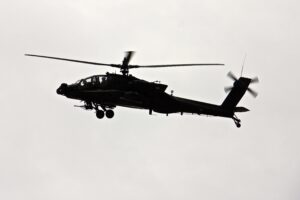
An AH-64 Apache from the 101st Airborne Division’s Combat Aviation Brigade. U.S. Army photo by Capt. Jarrod Morris, TAAC-E Public Affairs
A few months ago I asked the 101st Airborne, the Screaming Eagles, if I could ride around with their Combat Aviation Brigade (CAB) for a week, in order to write about the helicopters and a historical anniversary for the Division. The 101st is an Air Assault division now (helicopters used for combat troop transport, aerial offense and defense, and supply), not an airborne division (paratroopers), though it is in the XVIIIth Airborne Corps with the 82d Airborne. I did not realize it at the time, but it was a series of tough days for the CAB back then, and I never got approved to embed, which was disappointing.
Back in the Reagan-Bush era, I was stationed at Fort Campbell, Kentucky, home of the 101st, went to Air Assault School there, and rode around in Hueys, Chinooks, and Blackhawks a lot. More than any other aircraft I have been on, military helicopters provide the closest thing to a child’s dream of flight, in part because they so often fly low to the ground to evade detection and prevent attack, in what is called nap-of-the-earth flight. With the doors thrown open, turbines screaming, and running below treetop-level, often at night, the Blackhawks’ ride especially is impressive. I still dream about it, rarely.
That was a transitional period in our armed forces. Most of the pilots at Fort Campbell had been in Vietnam, and this was shortly after the famous “Desert One” crash during the Iran Hostage Crisis. From what I could tell there was a cowboy/post-cowboy split happening in military aviation culture, which you would recognize from The Right Stuff. There were rumors of pilots flying under highway bridges, and in the field, things got pretty wild. I have been reading there is a guideline for helicopter pilots to keep their airspeed at no more than half their altitude, but I remember craning around and looking at the gauges once, and we were doing 190 kph a few feet above a dirt road in Kentucky or Tennessee. When we popped over a small rise, a pickup truck was coming at us head-on, and the pilots cussed and pulled us roaring upward.
But as this news report from 15 years ago says, it is hard to encourage military pilots of all types to be aggressive, and to train them to be able to push their aircraft to their engineering limits in service to a mission, in all types of weather and hostile conditions, while telling them to “knock it off” with hotdogging. A training video mentioned in the article is said to show a pilot and copilot at Fort Campbell making a bet on whether their helicopter will fit between tall trees at 90 mph, 16 feet off the deck.
“Yeehaw,” the copilot yells before the crash.
Football fans got a little taste of helicopter excitement on November 14, when four CAB Blackhawk, Chinook, and Apache helicopters buzzed Nissan Stadium in Nashville during the Titans-Saints game. (A collage of videos of the flyover is in this report from a Nashville news station.) Some in the crowd freaked, saying they were in the nosebleed seats and could look down on the choppers flying over the field, and now investigations have been opened as to whether Army or FAA policies were violated. Usually, it seems, the rule would be for aircraft to stay a thousand feet up; there are some exceptions for helicopters, but apparently not to allow for flight that low over a crowd.
Pilots not involved in the incident told Task & Purpose that there would have been reconnoitering on the ground and in the air beforehand, and detailed planning for a flight path and maneuvers that would keep everyone safe. (High-tension wires, for example, are an aircraft’s enemy.) From a video at the Nashville news station’s site, it appears the helicopters did do a dry run, staying above the stadium. On gameday, however, they appear to drop into the bowl of the stadium and have to fly up to get out of it. In the racket from the engines and rotors, it must have been terrifying. The first idea for many in the crowd must have been “terrorist/rogue attack,” and no doubt some froze like little animals in the shadow of birds of prey.
There has been a creeping overlap between professional sports and the US military in recent years—culturally, politically, and economically. It is weird and jingoistic, and one wonders at the combination of macho and politics that thought a low flyover—fly in, some observers at the stadium said, which put civilians, including children, at risk for an entertainment—was a good idea.
